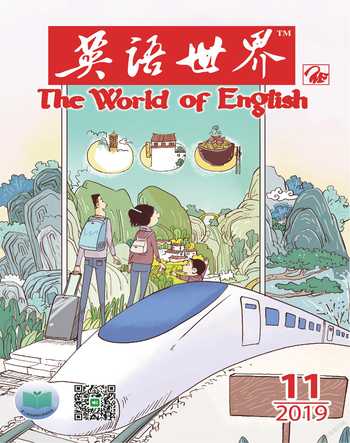Why Is Everybody Getting Married in a Barn?人们为何选在谷仓举办婚礼?
卡罗琳·基奇纳
It’s early May. Which means it’s wedding season. Which means a whole lot of Americans will soon be partying in a barn.
Millennials1, in staggering numbers, are choosing to start their married lives under high eaves and exposed beams, looking out over2 long, stripped-down3 wooden benches and lines of mason jars4. According to an annual survey from The Knot5, an online wedding-planning platform and magazine, 15 percent of couples chose a barn, farm, or ranch for their wedding reception in 2017, up from just 2 percent in 2009. Meanwhile, more traditional wedding locales are losing their appeal. (The number of couples choosing to celebrate in banquet halls dropped from 27 percent in 2009 to 17 percent in 2017; similarly, hotel receptions dropped from 18 to 12 percent.) Even if a couple isn’t actually getting married in a barn, there’s a good chance they’ll make their venue look like one, said Gabrielle Stone, a wedding planner based in Boston, Massachusetts. “There is this term that people use now: rustic chic.” Typically, that means couples will fill the space with homemade chalkboard signs and distressed6, vintage7 furniture. “And wooden water barrels,” Stone said. “Lots of water barrels.”
When I asked my first question—are barns popular because they’re cheap? Gwen Helbush, a wedding planner from San Francisco, laughed. “Don’t we wish it were so,” she said. While there are, surely, many relatively inexpensive barn weddings thrown in actual barns, by couples who actually live in rural areas with easy actual-barn access, anecdotal evidence8 suggests those probably aren’t what’s driving this trend. (Data is not available broken down by race, class, geography, or anything else—a level of granularity9 that would surely add to the picture of who is buoying this trend and why.)
Over the last few years, a wave of faux-barns, designed exclusively to host weddings, have popped up across the country. Venues like Virginia’s Pippin Hill Farm10, built in 2011, offer an experience that its owner Lynn Easton Andrews called “expensively understated.” “We’re not seeing bales of hay in the middle of the barn,” Stone said. “No one is wearing overalls, per se11.” The tarnished brass lamps and faded couches are generally hauled in from boutique vintage rental companies—another business booming with the barn-wedding industry—more akin to props than random, left-over farming accoutrements12.
Like earlier generations of Americans, Millennials want a beautiful (read: expensive) wedding. According to one widely-cited set of statistics, the average wedding cost has been steadily increasing, from $27,021 in 2011 to $33,391 in 2017. But, despite these price tags, many young couples today don’t want to be showy about it. Happier at a brewery than a fancy restaurant, accustomed to wearing jeans to work, many Millennials are proudly casual. There is a certain social capital that, as a 20- or 30-something, comes with being labeled “laid-back13” and “chill14.” “You’re going to be putting yourself out there in front of everyone you know and love and you don’t want to be judged harshly,” Helbush told me. The trappings15 of a traditional, formal wedding in a hotel ballroom—a fancy fish dish, a black-tie dress code, trays of champagne—are seen by many as stuffy and old-fashioned: chill’s antithesis.
When Easton Andrews asks couples to show her pictures of their dream wedding, the same type of image crops up16 a lot. “There are people sitting on long tables, clinking glasses, smiling,” she said. “It’s about how heartfelt it feels—people sitting together, breaking bread, sharing the experience.” Formality, for many Millennials, feels awkward. It adds pressure. If a wedding were clearly designed to be just-so17—not a table setting out of place—Millennials, Helbush said, may find it hard to relax. Barns and farms, on the other hand, eviscerate that pressure with their inherent informality. A guest can knock over a glass. Life will go on.
Young couples today, more than their parents or grandparents, see a wedding as an expression of their identity. Because they’re choosing to get married later than previous generations, Helbush finds that her clients today seem to know themselves better than her clients 30 years ago. “They’ve come into themselves more,” she said. “They know what they like and they aren’t afraid to ask for it.” Couples gravitate18 towards locales that say something about their personality. By choosing to get married in a barn, Easton Andrews said, a couple might want to show that they’re “connec.ted to nature.” Maybe they fell in love outside, hiking or camping. Other unique locales—historic homes and museums for history buffs19, and vineyards for wine lovers—are also having a moment in the wedding industry.
“It’s about the couple—who they are, and what they want to represent,” Helbush told me. “More than ‘How do I want other people to see me?’, it’s ‘How do I want to see myself?’” Many, she said, live in urban areas and have a fantasy about a life that is “calmer and less complicated”: a life removed from the big city, where couples and their guests can be one with the animals (or—if none are available—at least the spaces they could theoretically inhabit). A barn wedding typifies a simpler life, Helbush said.
五月的來临意味着婚礼季的到来,也意味着大批美国人即将欢聚于谷仓。
如今,不计其数的千禧一族选择在高耸的屋檐与裸露的房梁下、在简朴的长条木凳与成排玻璃瓶罐前开启他们的新婚生活。在线婚礼策划平台暨杂志The Knot的一份年度调查显示:2017年,15%的新人选择谷仓、农场或牧场作为婚礼场地,而2009年这一比例仅为2%。与此同时,传统的婚礼场地正愈发丧失吸引力。(选择在宴会厅举办婚礼的新人比例由2009年的27%降至2017年的17%;同样,在酒店举办婚礼的比例也由18%降至12%。)马萨诸塞州波士顿市的婚礼策划人嘉布丽尔·斯通说,即使一对新人并不是真的在谷仓中结婚,他们也很可能会把场地布置成谷仓的样子,“人们都在说‘乡野时尚’这个词”。通常而言,这意味着新人会在结婚现场摆上自己用粉笔手写的标语牌和老式仿旧家具。“还有木质水桶,”斯通说,“很多水桶。”
听到我提出的第一个问题“谷仓是因为便宜才受欢迎吗?”,来自旧金山的婚礼策划人格温·赫尔布什笑了。“我们倒也希望这样啊。”她说道。确实有许多相对廉价的谷仓婚礼是在真正的谷仓中举办,因为这些新人本来就生活在乡下,离真正的谷仓很近,但坊间证据表明,生活在乡下的新人可能并不是这一趋势的推动因素。(目前暂无按种族、阶层、地域或其他类别划分的数据,这些达到粒度级别的数据必将有助于判断谁是这一趋势的推动力,原因又是何在。)
过去几年,全国各地涌现出一批专门为举办婚礼设计的仿制谷仓。弗吉尼亚州的皮平山农场建于2011年,农场主林恩·伊斯顿·安德鲁斯将这种场所带给人们的体验称为“昂贵的低调消费”。“谷仓里我们看不到成捆的干草,”斯通说道,“本身也没有人穿工装。”失去光泽的黄铜灯和褪色的沙发一般都是从精品老物件租赁公司(谷仓婚庆产业带动起来的另一行业)运过来的,它们更像是道具,而非随意留下来的农用装备。
同老辈的美国人一样,千禧一族也想要华美的(意即:昂贵的)婚礼。一组广为引用的数据显示:婚礼的平均花费一直在稳步上升,从2011年的27021美元升至2017年的33391美元。然而,尽管价码不低,如今许多年轻情侣却并不想张扬。许多千禧一族更喜欢啤酒厂,而不是高档饭店,他们习惯穿着牛仔裤去上班,并为这种随意感到自豪。二三十岁年轻人的标签就是“随性”和“酷炫”,这已成为某种社交资本。“你是要把自己呈现在所有熟人和至親面前的,不想受到大家的犀利品评。”赫尔布什告诉我。高档鱼肴、半正式着装规范、托盘香槟,这些都是在酒店舞厅举办的那种传统、庄重的婚礼的标配,在许多人看来却是既古板又老旧,与“酷炫”截然相反。
当伊斯顿·安德鲁斯让新人们向她描述他们梦想的婚礼场景时,大家多是想到了相同的画面。“人们坐在长桌前,酒杯相碰,面带微笑。”她说道,“那是一种发自内心的感受——人们坐在一起,分食面包,共享这种体验。”而拘泥于礼节会让许多千禧一族很不自在、备感压力。赫尔布什说,如果把婚礼策划得十分正规,没有一张桌子摆放不当,那么千禧一族可能很难放松下来。相反,谷仓和农场正是以其固有的非正式感消除了这种压力。宾客可以打翻玻璃杯,生活照样继续。
相较于父辈或祖父辈,如今的年轻情侣更是将婚礼视为自我身份的表达。他们情愿比老辈人更晚结婚,这让赫尔布什发现,今天的客户似乎比30年前的客户更加了解自我。“他们更明白自己的需求,”她说,“知道自己喜欢什么,而且不怕去争取。”新人们倾向于选择能表达个性的场所。伊斯顿·安德鲁斯说,他们选择在谷仓举办婚礼,或许是想展示自己“与大自然的关联”。也许他们是在户外活动中坠入爱河的,比如在远足或露营期间。其他一些独特的场所,比如吸引历史爱好者的古宅和博物馆、吸引葡萄酒爱好者的葡萄园,也在婚庆产业中热度大升。
“关键在于新人自己的想法——他们是谁,他们想表现什么。”赫尔布什告诉我,“相比‘我想让别人怎样看待我?’,人们更关注‘我想怎样看待自己?’”她说,许多人生活在城区,对那种“更为宁静、更为简约”的生活情有独钟,那是一种远离大都市的生活,新人和宾客可以与自然界的动物融为一体(或者,如果没有动物,至少理论上可以与其栖息的空间融为一体)。赫尔布什说,谷仓婚礼象征着一种更为简单的生活。
(译者单位:北京外国语大学高级翻译学院)
- 英语世界的其它文章
- High Speed Trains高速列车
- 9 Fastest Trains in the World全球最快九大列车
- Why China Can Build High-speed Rail So Cheaply为何中国高铁成本如此之低?
- China’s Most Epic High-speed Rail Journeys中国最美高铁之旅
- Bullet Trains Are Transforming the World’s Biggest Migration高铁改变全球最大规模的人口流动
- Chinese Shops Are Set to Add “Beauty Mode” to Their Facial-Recognition Payment System中国商店刷脸支付增设“美颜模式”

